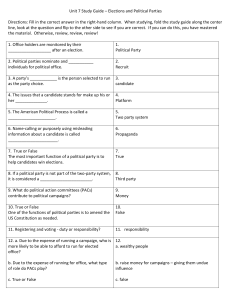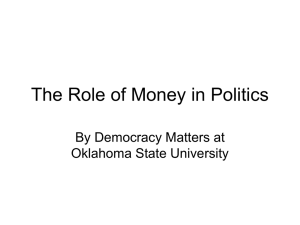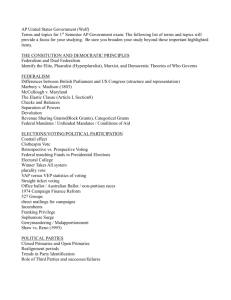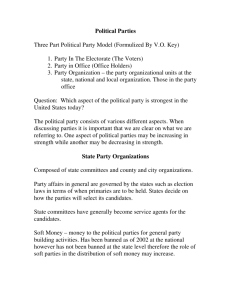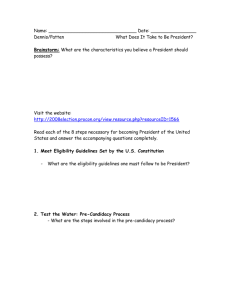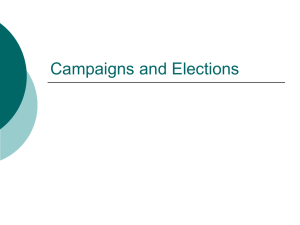Chapter 7 “Participation and Voting” Text “NOTES” ______ is
advertisement
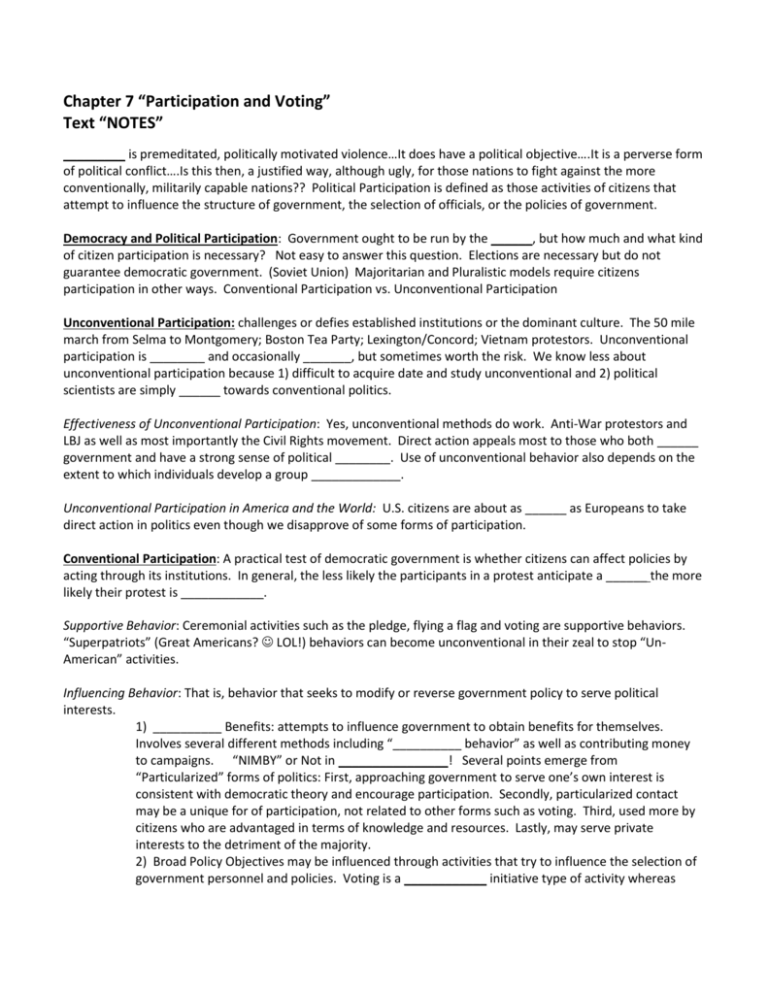
Chapter 7 “Participation and Voting” Text “NOTES” _________ is premeditated, politically motivated violence…It does have a political objective….It is a perverse form of political conflict….Is this then, a justified way, although ugly, for those nations to fight against the more conventionally, militarily capable nations?? Political Participation is defined as those activities of citizens that attempt to influence the structure of government, the selection of officials, or the policies of government. Democracy and Political Participation: Government ought to be run by the ______, but how much and what kind of citizen participation is necessary? Not easy to answer this question. Elections are necessary but do not guarantee democratic government. (Soviet Union) Majoritarian and Pluralistic models require citizens participation in other ways. Conventional Participation vs. Unconventional Participation Unconventional Participation: challenges or defies established institutions or the dominant culture. The 50 mile march from Selma to Montgomery; Boston Tea Party; Lexington/Concord; Vietnam protestors. Unconventional participation is ________ and occasionally _______, but sometimes worth the risk. We know less about unconventional participation because 1) difficult to acquire date and study unconventional and 2) political scientists are simply ______ towards conventional politics. Effectiveness of Unconventional Participation: Yes, unconventional methods do work. Anti-War protestors and LBJ as well as most importantly the Civil Rights movement. Direct action appeals most to those who both ______ government and have a strong sense of political ________. Use of unconventional behavior also depends on the extent to which individuals develop a group _____________. Unconventional Participation in America and the World: U.S. citizens are about as ______ as Europeans to take direct action in politics even though we disapprove of some forms of participation. Conventional Participation: A practical test of democratic government is whether citizens can affect policies by acting through its institutions. In general, the less likely the participants in a protest anticipate a ______ the more likely their protest is ____________. Supportive Behavior: Ceremonial activities such as the pledge, flying a flag and voting are supportive behaviors. “Superpatriots” (Great Americans? LOL!) behaviors can become unconventional in their zeal to stop “UnAmerican” activities. Influencing Behavior: That is, behavior that seeks to modify or reverse government policy to serve political interests. 1) __________ Benefits: attempts to influence government to obtain benefits for themselves. Involves several different methods including “__________ behavior” as well as contributing money to campaigns. “NIMBY” or Not in ________________! Several points emerge from “Particularized” forms of politics: First, approaching government to serve one’s own interest is consistent with democratic theory and encourage participation. Secondly, particularized contact may be a unique for of participation, not related to other forms such as voting. Third, used more by citizens who are advantaged in terms of knowledge and resources. Lastly, may serve private interests to the detriment of the majority. 2) Broad Policy Objectives may be influenced through activities that try to influence the selection of government personnel and policies. Voting is a ____________ initiative type of activity whereas attending meetings, running for office, writing letters, and taking a case to court are __ ___initiatives (Brown v. Board of Ed.) Studies show that 2/3 of those who contact are for broad social issues and only about a 1/3 are for private gain. Conventional Participation in America: In a democracy, this is most likely ______ for candidates. However, in America voting for candidates is less common than in other countries. Paradox: Americans are as likely, or more likely, than others to participate, but less likely to vote. Participation Through Voting: According to democratic theory, everyone should be_____________. In practice , no nation guarantees the right to vote to_________. All countries have requirements. Expansion of Suffrage: The U.S. was the first nation to provide for “____” suffrage, but was it truly “mass” suffrage? White, male, 21, property owners. 1) The Enfranchisement of African-Americans: 15th Amendment; “_____ primaries” and Smith v. _________; Voting Rights Act of ____; Poll taxes and ______ v. Virginia State Board of Elections. 2) The Enfranchisement of Women: 19th Amendment; (also 18 year-olds through the 26th amendment. Voting on Policies: Disenfranchised groups have struggled to gain voting rights because of the ______________ that comes with suffrage. “______________” was an attempt to control the government through the ballot box. It trusted the goodness and wisdom of the people and distrusted “________________” and political institutions (parties). It championed direct primaries, recalls, referendums, and initiatives. Does big money really control this? The question is; do these forms of direct democracy improve on the policies made by representatives elected for that purpose? Voting for Candidates: Serves democratic government in two ways: 1) citizens can choose candidates they think will best serve their interests. 2) voting allows people to reelect the officials they guessed right about and to kick out those they guessed wrong about. This second way makes public officials accountable and assumes voters know what is happening while they are in office. Explaining Political Participation pp221-230 (on your own there!) Participation and Freedom, Equality, and Order: What is the relationship of political participation to the values of freedom, equality, and order? Participation and Freedom: Individuals should be free to participate as they wish, even if that means not _____________. In theory, that must also mean one can use their wealth, connections, knowledge, etc. any way possible (as long as it is legal) to influence government decisions. Participation and Equality: Each citizen’s ability to __________ government should be equal to every other citizen. Differences in resources should not hurt the poor in this area. One person, one vote cancels any differences in resources between people. Participation and Order: the relationship between participation and order, unlike the relationship between participation and freedom and quality, is complicated. Some types of participation promote order and are encouraged. Others are not. Chapter 9 “Nominations, Elections, and Campaigns” Text “NOTES” The Evolution of Campaigning Political Parties used to do the campaigning for the candidate but today’s campaigns rely on political consultants and clever sound bites. The message gets to the voters through media campaigns, not so much by canvassing neighborhoods. Campaigns have gone from party centered to candidate centered. However, the party label is usually a candidate’s prime attribute at election time. A big change: one must now campaign for the nomination prior to the campaign for the election AND candidates are no longer nominated by the party organization but within the party. That is, party leaders seldom choose candidates; they merely organize and supervise the election process by which party voters choose the candidates. Nominations We are unusual compared to most of the rest of the world. We have elections to nominate our candidates. We use a primary election to nominate the candidates and each state has their own rules for this process. This illustrates the highly decentralized nature of our system. Until the 1960’s party delegates chose the nominee at convention but today, with the selection of delegates by the voters, we know who the candidate is prior to the convention. Who votes in the primaries? Only about ¼ of the VAP actually votes. Are these voters extremist ideologues who do not represent the average person who does not participate? There are mixed results in surveys, yes and no. Conservatives and liberals subordinate their extremist feelings to choose a candidate who will more likely win in the general election (November) There are closed primaries meaning voters must register their party affiliation to vote on that party’s potential nominees. There are Open primaries meaning the voter can choose either party’s ballot regardless of how one is registered. There is no national law which specifies how state parties must select their delegates to the national convention. 3 states use different types of primaries, whereas 1 states use caucuses and state conventions. Other 10 states? One party may use a primary while the other party uses a caucus/state convention method. Today, a lot of states are front-loading which means that they are moving their primaries to an earlier date so they can have more of an impact on the presidential race and thus more media coverage. Invisible Primary? The campaign actually starts four years ahead of time when the candidates start lining up political and financial support. Elections The general election is held in November of even-numbered years in order to elect state and local officials and the president during presidential election years. The intervening elections years may be referred to as congressional, midterm, or off-year elections. The book goes into some detail about the Electoral College, we covered a lot of this in our lecture notes. Any EC questions on the test will come from info in our notes. About half of all voters are split ticket voters as opposed to straight ticket voters. This pattern will sometimes produce a divided government. Presidency controlled by one party with Congress controlled by the other. (Obama faces this dilemma in 2011) Campaigns The Political Context – incumbents in the H or R are almost impossible to defeat winning 95% of the time. Incumbent senators are equally difficult to defeat but there is often an opponent with greater name recognition. Strategy of the candidate will depend upon the physical size, the sociological make up, (diversity) and size of the population. A more complicated and expensive campaign. There may be a decreased influence of party affiliation on voting behavior today, but the party preference of the electorate is an important factor in the context of the campaign. It is still easier to get elected when his or her party matches the electorate’s preference. Easier to raise money as well. And, significant political issues such as economic recessions, scandals and war can negate the advantage of incumbency. (Look at the elections we just had, that illustrates this point!!) Financing - campaign resources boil down to campaign funds, pays for travel, staff salary, advertising, etc… The Federal Elections Commission (FEC) was formed to enforce limits on financial contributions to national campaigns (not state and local) and require full disclosure of campaign spending as well as administer the public financing of presidential campaigns. One of these limits is hard money which is money directly given to a candidate ($2000). Buckley v. Valeo upheld the limits on hard money but also ruled that an individual could spend as much money as they wish out of their own pockets and any individuals or organizations that campaigned independently on behalf of a candidate can spend as much money as they want, this is a form of free speech. The FEC also allowed public financing of primaries and presidential general election campaigns. The BCRA (Bipartisan Campaign Reform Act) of 2002 outlawed the spending of soft money which was unlimited amounts of money previously given for party mailings, voter registration, and get out the vote campaigns. This ban on soft money did not extend to state parties and issue advocacy groups called 527 Committees (MoveOn.org, Swift Boat Veterans for Truth). 527’s cannot expressly advocate the election or defeat of a candidate. Campaigns for office have strategy and tactics: 1) Party centered strategy which relies on voter’s party identification, best suited for those with little political knowledge (Christine O’Donnell) 2) Issue-oriented strategy which feels strongly about certain policies 3) Image-oriented strategy which depends on experience, integrity and trustworthiness. Strategy: polling (focus groups) professional campaign managers, name recognition, and free news coverage (incumbent advantage), extol their virtues (McCain and POW), use of attack ads or contrast ads, the internet. Explaining Voting Choice Party Identification – half the electorate decides to vote prior to the conventions in late summer. This is the most important long term force. Issues and Policies - incumbents compile a record in office and try to campaign on their accomplishments Candidates’ attributes – some people fall back on their personal beliefs about religion, gender, and race in making political judgments. JFK and catholics, Geraldine Ferraro and women, (Obama???) Most studies show that issues are less important to the voter. Sad for democratic theory. Presidential elections are not truly a national election to be fought across the nation but a federal election whose outcome would be decided in certain “battleground” or “swing” states.
